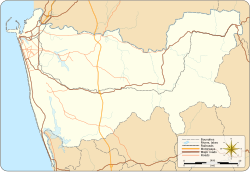2 아우리개
2 Aurigae| 관측 데이터 Epoch J2000.0 이쿼녹스 J2000.0(ICRS) | |
|---|---|
| 별자리 | 오리가 |
| 우측 상승 | 04h 52m 37.98097s[1] |
| 탈위임 | +36° 42′ 11.4789″[1] |
| 겉보기 크기 (V) | +4.79[2] |
| 특성. | |
| 스펙트럼형 | K3-III Ba0.4[3] |
| B-V색지수 | 1.414±0.003[4] |
| 아스트로메트리 | |
| 방사 속도 (Rv) | -17.24±0.08km[4]/s |
| 고유 운동 (μ) | RA: −25.731[1]mas/yr Dec.: -3.867[1] mas/yr |
| 시차 (π) | 6.3340 ± 0.2695[1] 마스 |
| 거리 | 510 ± 20 리 (105 ± 7 pc) |
| 절대치수 (MV) | –1.84[2] |
| 세부 사항 | |
| 미사 | 2.86[5] M☉ |
| 반지름 | 48.14+0.83 −1.79[1] R☉ |
| 루미도 | 599±29[1] L☉ |
| 표면 중력 (log g) | 1.79[6] cgs |
| 온도 | 4,115+79 −35[1] K |
| 금속성 [Fe/H] | −0.24±0.03[4] 덱스를 만들다 |
| 회전 속도 (v sin i) | 2.3km[6]/s |
| 나이 | 1.80[5] Gyr |
| 기타 지정 | |
| 데이터베이스 참조 | |
| 심바드 | 자료 |
2 오리는 북쪽 별자리인 오리가에서 가능한 이진 항성계통이다.이 물체는 육안으로 볼 때 가시적 크기가 +4.79인 희미한 주황색 후두의 항성으로 보인다.[2]저전력 아이피스로 볼 때 주변의 HIP 22647과 또 다른 매우 느슨한 시각 쌍인 HIP 22776, HIP 22744와 함께 모두 진도 8 이상의 4성 별을 형성한다.2 오리는 태양 중심 방사상 속도로 지구 가까이 이동하고 있다.[4]
가시성 성분은 K3-III Ba0.4의 별 분류를 가진 노화된 거대 항성이다.[3]접미사 표기법은 이것이 순한 바륨 별임을 나타내며, 이는 항성 대기가 s-공정 원소로 풍부함을 의미한다.그것은 밀접한 이항체계의 일원으로서 이전에 (지금의) 백색 왜성 동료로부터 이 원소들을 획득했거나, 그렇지 않으면 점증하지 않는 거대 분지에 있으면서 원소 자체를 생성시키고 있다.[8]2 오리는 태양 질량의[5] 2.86배인[5] 18억 8천만 년으로 태양 반지름의[1] 48배까지 확대되었다.그것은 4,115 K의 유효 온도에서 확대된 광권으로부터 태양의 599배의[1] 광도를 방출하고 있다.[1]
참조
- ^ a b c d e f g h i j k Brown, A. G. A.; et al. (Gaia collaboration) (August 2018). "Gaia Data Release 2: Summary of the contents and survey properties". Astronomy & Astrophysics. 616. A1. arXiv:1804.09365. Bibcode:2018A&A...616A...1G. doi:10.1051/0004-6361/201833051.이 소스에 대한 가이아 DR2 기록 VizieR.
- ^ a b c Jasniewicz, G.; et al. (February 1999), "Late-type giants with infrared excess. I. Lithium abundances", Astronomy and Astrophysics, 342: 831–838, Bibcode:1999A&A...342..831J
- ^ a b Keenan, Philip C.; McNeil, Raymond C. (1989), "The Perkins catalog of revised MK types for the cooler stars", Astrophysical Journal Supplement Series, 71: 245, Bibcode:1989ApJS...71..245K, doi:10.1086/191373.
- ^ a b c d Anderson, E.; Francis, Ch. (2012), "XHIP: An extended hipparcos compilation", Astronomy Letters, 38 (5): 331, arXiv:1108.4971, Bibcode:2012AstL...38..331A, doi:10.1134/S1063773712050015, S2CID 119257644.
- ^ a b c d Luck, R. Earle (2015), "Abundances in the Local Region. I. G and K Giants", Astronomical Journal, 150 (3), 88, arXiv:1507.01466, Bibcode:2015AJ....150...88L, doi:10.1088/0004-6256/150/3/88, S2CID 118505114.
- ^ a b Takeda, Y.; Tajitsu, A. (August 2017), "On the observational characteristics of lithium-enhanced giant stars in comparison with normal red giants", Publications of the Astronomical Society of Japan, 69 (4): 978–88, arXiv:1706.02273, Bibcode:2017PASJ...69...74T, doi:10.1093/pasj/psx057.
- ^ "2 Aur". SIMBAD. Centre de données astronomiques de Strasbourg. Retrieved 2019-04-03.
- ^ Gomez, A. E.; et al. (1997), "Absolute magnitudes and kinematics of barium stars", Astronomy and Astrophysics, 319: 881, Bibcode:1997A&A...319..881G.




